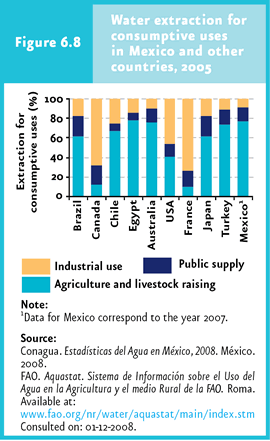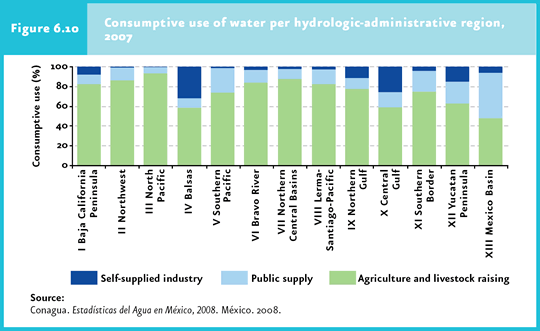
77 percent of the water extracted in the country is devoted to farming activities. |
| CHAPTER 6. WATER |
Water extraction throughout the world has increased significantly in an attempt to supply the agricultural, electricity generation and human consumption needs of an ever increasing population. In 1995, the world´s freshwater extraction was 3 thousand 790 cubic kilometers. In that year, 59% of the world extraction was made in Asia, where the largest areas of irrigated agriculture are located. Predictions point out that the annual global extraction might grow between 10 and 12% per year every 10 years, reaching some 5 thousand 240 cubic kilometers by the year 2025 (Shiklomanov, 1999). In Mexico, it is estimated that 79 cubic kilometers of water were extracted from the rivers, lakes and aquifers of the country in 2007 to supply the major consumptive uses; this amount represents 17% of the available water (IB 2.1-2). Following the global trend, most of the water extracted in Mexico is dedicated to farming activities: 77% is used for irrigating 6.5 million hectares and for cattle-raising and aquaculture. In the year 2006, the irrigated agricultural surface accounted for one fourth of the cultivated area and produced over half of the country’s agricultural production. This is followed by the use for public supply, with 14% of the total volume of water extracted; industrial uses represent 9% (Figure 6.7; see the Box Hydrological footprint, consumptions patterns and international trade). Among the non-consumptive uses of water, in 2007 hydroelectric power plants used 123 cubic kilometers of water to produce 29 thousand 700 GWh of electricity (13% of the country´s total).
Water distribution for consumptive uses differs between countries and regions depending on its availability, the type and capacity of the local industry and agriculture, as well as of the population and its consumption patterns. For instance, with regard to public supply, people in developed countries consume, on average, nearly ten times the amount of water that people in developing countries do (UNESCO 2000, cited in UNEP 2002). In general, water distribution in Mexico for the various consumptive uses is similar to that in countries such as Australia, Egypt and Turkey, but is significantly different from most industrialized countries, where the proportion devoted to industrial uses is far higher, as is the case in Canada and France (Figure 6.8).
The hydrological-administrative regions of Mexico where water extraction is the highest are Lerma-Santiago-Pacific, Balsas, Northern Pacific and Bravo River, whereas those with the lowest consumption are Southern Pacific, Southern Border and the Yucatan Peninsula (Figure 6.9). If water extraction is analyzed according to source, the largest volume comes from surface sources: considering the water consumed, in the year 2007 63% of its volume came from these sources and the remaining 37% from groundwater. Water extracted from surface sources increased 12% between the years 2000 and 2007, but groundwater extraction remained virtually unchanged (IB 2.1-3). There are marked differences within the country with regard to the proportion of surface and groundwater that is used. For example, in the Northern Pacific, Central Gulf and Balsas regions, water comes mostly from surface sources (87, 82 and 83 %, respectively), whereas in the regions of the Northern Central Basins and Yucatan Peninsula, a considerable proportion of the water used is groundwater (68 and 99%, respectively; Figure 6.9; Cuadro D3_AGUA03_03).
The use of surface water showed only minor changes in most regions of the country between the years 2000 and 2007. In the Yucatan Peninsula, the use of underground water increased 80% over that same period of time. If consumptive water uses are analyzed at the regional level, important differences can be observed. In 2007, while 93% of water in the Northern Pacific region was devoted to farming activities, this proportion was lower than 50% in the Valley of Mexico region (the country´s region with the lowest consumption for agricultural use) (Figure 6.10, Cuadro D3_AGUA03_03). However, with regard to water for public supply, the Aguas del Valle de Mexico (46%), Yucatan Peninsula (22%), Southern Pacific (25%) and Southern Border (21%) regions are those which, proportionately, allocate the largest volume of water. Less water is allocated for industrial uses, in general, than for public supply, except for the Balsas, Northern Gulf and Central Gulf regions.
At a national level, the water supplied for agriculture and the self-supplied industry mostly comes from surface sources (67 and 74%, respectively), as opposed to water for public uses, which comes mainly from underground sources (62%). Between the year 2000 and 2004, the use of surface and underground water for public supply increased 50 and 20% respectively; whereas the industrial use of surface water doubled from the year 2000 to 2006 (Figure 6.11, Cuadro D3_AGUA03_03). Extraction of both surface and groundwater for public supplies increased less than 1% between 2004 and 2006; whereas groundwater extraction for industrial uses increased nearly 20% between 2000 and 2006.
In order to determine how consumptive uses affect the sustainability of underground resources, the Use Intensity index can be employed; this index is calculated as the ratio between groundwater extraction and the average recharge of aquifers. The total volume of groundwater licensed in 2007 for the various consumption uses was 28.9 cubic kilometers (6 % larger than the volume extracted in 2004), which represented 35% of the estimated annual recharge in Mexico. This figure seems to indicate, on the one hand, a positive balance in the exploitation on the country’s groundwater and, on the other, the existence of an important reserve of useable water for the future. However, when this situation is analyzed at a regional scale, the view is radically different. In 2007, the use intensity of groundwater showed considerable deficits (that is, the volume of water used exceeded recharge) in the Baja California Peninsula and Aguas del Valle de Mexico regions, with figures of 145 and 126%, respectively. Nevertheless, the Northern Central Basins region also showed a deficit of around 14% (Map 6.5; Cuadro D3_AGUA02_01; IC 11).
The situation of groundwater in Mexico is serious, mainly due to the heavy exploitation of this water source in many regions. Since the 1970s, the number of overexploited aquifers has been increasing. There were 32 overexploited aquifers in 1975, 36 in 1981, 80 in 1985, 102 in 2003 and 104 in 2006. However, by 2007 this number dropped to 101, accounting for 15% of the 653 aquifers in which the country has been divided. Overexploited aquifers concentrate in the Baja California, Northwest, Central, Northern Basins, Bravo River and Lerma-Santiago-Pacific hydrological regions (Map 6.6; Cuadro D3_AGUA02_04). 58 percent of groundwater is extracted from these aquifers for all kinds of uses (Conagua, 2007).
In addition to overexploitation, 17 aquifers show saline intrusion (10 of these are overexploited), mostly those located along the coasts of Baja California, Baja California Sur, Sonora, Veracruz and Colima (Cuadro D3_AGUA02_03; IB 2.1-7). In extensive areas of irrigated agriculture, the overexploitation of aquifers has led to a drop of tens of meters in groundwater levels, as is the case of the Maneadero y Camalu aquifers in Baja California, in which reductions of over 12 meters in the static level have been recorded in areas close to the coast, this has also favoured the intrusion of marine water and the deterioration of water quality.
Future scenarios The fundamental problem with water availability is that the total amount of water is virtually constant, as opposed to the demand of an ever-increasing population that requires larger amounts of food, manufactured products and energy. Water scarcity is, therefore, one of the most critical topics in the global environmental agenda. The United Nations (2007) acknowledge four basic forces that may increase water scarcity over the next decades. The first of them is population growth. In the year 2005, the world´s population reached 6 thousand 400 million persons, and it is expected that, by 2050, it may be as large as 8 thousand 900 million persons, significantly affecting the per capita water availability. It is estimated that, by 2025, nearly one thousand 800 hundred million persons will live in countries or regions with complete water scarcity, while two thirds of the world´s population might be exposed to conditions of hydric stress (UNEP, 2007). In Mexico, the per capita water availability was 4 thousand 312 cubic meters in 2007, which will decrease to just 3 thousand 783 cubic meters per inhabitant per year by 2030 (Conagua, 2008). At a regional level, in 2006 the per capita water availability in three hydrological-administrative regions was already classified as very low, and that in the Aguas del Valle de Mexico region was extremely low. By the year 2030, considering that the natural water availability will remain constant, forecasts show that two additional regions, the Baja California Peninsula and Bravo River regions, will have an extremely low water availability, whereas the Balsas and Central Northern Basin region (which currently have a low per capita availability) will have a very low water availability (Table 6.3).
The second cause of water scarcity is the increasing urbanization of countries, which might exacerbate this issue as a result of the growing demand by a larger, more concentrated population (UN, 2007). In 1950, of the 2 thousand 500 million inhabitants in the Earth, only 29% lived in urban areas, and the remaining 71% (around one thousand 800 million persons) lived in rural areas. By the year 2050, according to estimates, this situation will be reversed: nearly 70% of the world’s population (6 thousand 400 million) will live in cities and the rest (30%, that is, 2 thousand 790 million persons) will live in rural areas (UN, 2008). Mexico has followed a similar urbanization pattern. In 1970, 51.7% of the population lived in urban areas, and this will increase to 68% in the year 2030 (Conapo, 2006; Reyna y Hernández, 2006), which might exacerbate the critical condition of water supply in the most highly urbanized regions such as the central and Western parts of the country. Ranking third as an underlying cause of water scarcity is the per capita consumption. As economic development increases the welfare of a given country, the per capita water consumption tends to grow (UN, 2007). Finally, while the above factors modify water demand, climate change will have an important effect by modifying water availability worldwide. If climate change follows the projected scenarios, a more erratic climate will be observed in the future; this will involve a higher variability in precipitation, a higher risk for agricultural crops and a more variable water supply for population.
|







